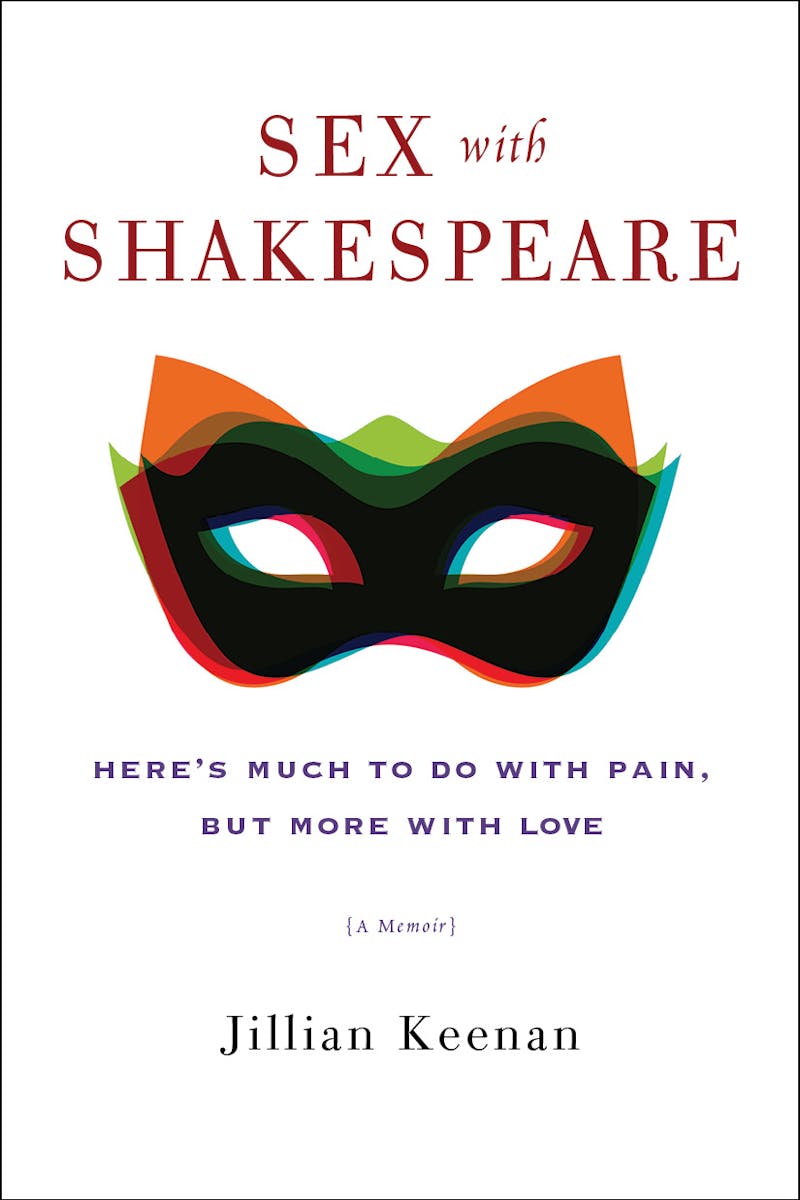
Put your head on your lover’s chest and you will hear ba-bump, ba-bump, ba-bump. It’s a heartbeat, but it’s also a very specific rhythm—it’s iambic pentameter, the metrical foot made famous by William Shakespeare. Even if you don’t know your trochee from your spondee, you know an iamb. You can’t not know it; iambs are the poetry of your lover’s blood, your mother’s blood, and of your own.
Iambic pentameter matters a lot to Jillian Keenan, whose new memoir Sex with Shakespeare spins a story of reading and readership, like Phyllis Rose’s The Year of Reading Proust or Azar Nafisi’s Reading Lolita in Tehran, but with something specific in mind: using Shakespeare to explore her relationship with her sexuality. Keenan is “obsessed with spanking,” to use her own words, and she is also obsessed with Shakespeare. In this unusual memoir, one obsession informs the other like a metaphor, where the known—in this case, 14 of Shakespeare’s best loved plays—explains the unknown.
It might seem strange to put Shakespeare in bed with spanking, but for the most part Keenan makes it work, and the matchmaker of this strange relationship is Shakespeare’s own language. “At its most basic level, Shakespeare is physical and biological,” Keenan writes in the opening chapter. “His words circulate, speed up and slow down, skip beats and flutter in perfect symmetry with the human heart.” Shakespeare’s iambs run a thrilling tattoo throughout the book, appearing not only in the close readings that Keenan handles deftly, but also punctuating the narrative at perilously climactic moments. The iamb’s ba-thump is the bleeding, beating heart of this book.
In our post-Fifty Shades of Grey world, you might wonder why Keenan needs 300 pages to explain a spanking fetish. Coming into this book, I thought I had a sense of what it meant to be a fetishist; I like to avail myself of a full range of sexual expression, and I’ve a bag under my bed that, among other implements, holds a well-used leather crop and a worn black leather spanker. But even my recherché history didn’t give me an adequate perspective to appreciate the depth of Keenan’s spanking fetish. I don’t mean that glibly. I mean to say that coming to the end of Sex with Shakespeare, I agree with Keenan’s contention that fetish is a “sexual identity,” and I’m not sure I would have gotten there without the book’s length or without the help of Shakespeare.
Shakespeare fans will recognize that Keenan’s subtitle—“Here’s much to do with pain but more with love”—plays fast and loose with a line from Romeo and Juliet: “Here’s much to do with hate but more with love.” As this rewriting suggests, the book plays with Shakespeare, almost skipping rope with the dramatist’s many characters. The Taming of the Shrew’s Kate, A Winter’s Tale’s Hermione, King Lear’s Cordelia, and many others drop in on Keenan, chatting with her over oysters or playing devil’s advocate in the back of cabs. Shakespeare’s best-loved characters seem to know Keenan on a first-name basis, and this conceit is sometimes distracting, feeling at once a little precious and a little forced, even as these scenes illustrate the easy familiarity of best friends or long-term amours.

Shakespeare’s characters appear like a stream of sherpas or Yodas, helping Keenan shoulder the psychic burden of her fetish, and Keenan uses The Taming of the Shrew’s Kate with particular nuance and depth. In her final year of high school, Keenan sends herself to Spain and finds herself sharing a flat with John, the first man who will give her what she needs: a skillful, righteous, and thoroughly satisfactory spanking. Still, Keenan struggles to parse the emotional fallout of finding her kink satisfied, a point that falls into high relief when she realizes that a neighbor has seen her getting spanked and worries that the woman will think that what she witnessed was abuse.
The Taming of the Shrew has conventionally been understood as a narrative that dabbles—if not wades—in spousal abuse. But Keenan adroitly reads the play differently, arguing that from the first meeting of Kate and Petruchio, “their relationship is built on a foundation that emphasizes her sexual satisfaction over even his own.” Shrew, she argues, plays with the roles of “shrew and madman,” and it plays with “taming.” Neither things nor people are as they seem: Kate appears at a critical juncture and asks Keenan to look in the mirror and accept her reflection. The way things appear to others, she essentially says, is not how they really are, and Keenan uses The Taming of the Shrew, Kate, and her neighbor’s voyeurism to accept that a relationship “only needs to make sense to two people.”
“Literature is a conversation,” Keenan writes. “Books are walkie-talkies, not radios.” Keenan started her conversation with Shakespeare early, falling in love with The Tempest at 15, and she frames each chapter of her memoir around a play, using Macbeth’s doubleness or Othello’s uneasy political bedfellows as framing for the unfurling of her acknowledgement, exploration, alienation from, and eventual acceptance of her spanking fetish. For example, when confronted with a judgmental, unremittingly vanilla boyfriend, Keenan uses Hamlet’s “nothing,” a concept that sits at the center of the play as well as a word he uses to humiliate Ophelia, to mourn her loss even as it expresses the scorn of the vanilla boyfriend. Each chapter hews closely to a framework that juggles Keenan’s life story, a Shakespeare play as a thematic anchor, and conversations with a Shakespeare character or two. This format provides a narrative loopiness that is equally maddening and necessary.
Often, the structure of Keenan’s memoir feels like the circling of a hawk. You see narrative points from on high as she moves in seemingly lazy spirals until she drops on these moments like a bird of prey. Writing the details of her life—her first boyfriend who “got” her kink, her childhood discovery of spanking, her uneasy relationship with her mother, her college lover who expressed pity over her need for pain, her internal battles over being “fucked up,” and her falling in love with the man who would become her husband—Keenan repeats her assertion that her kink is her sexual identity. Every repetition is an underlining, but it’s also another maddening arc in those raptor circles. It takes a very long time for Keenan to drop to the ground and nail her most painful tidbits, and it’s not always a rewarding hunt.
When she writes about Shakespeare and gets her hands dirty with his text, Keenan is at her most confident. Her prose soars with a clarity of vision and purpose. Writing about her own feelings, however, Keenan lapses into a kind of young girl’s breathlessness; she blushes, she stammers, she uses language that wouldn’t be out of place coming from Fifty Shades’ Anastasia Steele. You walk away from the book thinking that this is a super-nice, super-smart woman with a super-specific sexuality, and you might feel bad for her if it weren’t a love story and if she weren’t a skilled writer and thinker.
“Spanking is not part of my sex life,” she says, “spanking is my sex life,” and then she admits, “I could almost drop the word sex from that sentence.” It’s hard to imagine a sex life that deprioritizes actual sex, but Keenan does show how her kink—at some points called spanking, at other times masochism—is uncoupled from heteronormative sex. The activities that you and I most likely rely upon in the chase for physical satisfaction run a distant second or third for Keenan, a point she needs to make repeatedly to have it sink into non-fetishists’ heads. In reiterating the primacy of her fetish, Keenan also explores a host of ancillary issues: domestic abuse, sexual shame, childhood sexual abuse, sexual acceptance, and the primacy of communication and trust.
Keenan writes a story of language and lust, and the pain of trying to get to that thing you want but you can’t quite put into words. “Pain,” Keenan says, “suffers the same linguistic famine” as love. “There is the pain that empowers; pain that arouses; pain that frightens; pain that motivates; pain that discourages; pain that encourages; pain that recalls; pain that predicts; pain that breaks; pain that heals.” In this last, the pain that heals, Keenan finds a contradiction she can live with, celebrate, and revel in. This book is, after all, a love story: one in which the author finds a way to live happily with her sexuality, with Shakespeare, and in the iamb of her loved-one’s heartbeat.